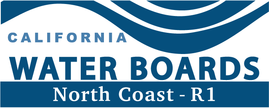Sediment TMDL Implementation
Approximately 61% of the North Coast Region drains to rivers and streams that are impaired by too much sediment (2006 Clean Water Act Section 303(d) list).
Sediment TMDL Implementation Policy
As part of our efforts to control sediment waste discharges and restore sediment impaired water bodies, the Regional Water Board adopted the Total Maximum Daily Load Implementation Policy Statement for Sediment Impaired Receiving Waters in the North Coast Region, which is also known as the Sediment TMDL Implementation Policy, on November 29, 2004. This Policy was adopted through Resolution R1-2004-0087.
The Sediment TMDL Implementation Policy states that Regional Water Board staff shall control sediment pollution by using existing permitting and enforcement tools. The goals of the Policy are to control sediment waste discharges to impaired water bodies so that the TMDLs are met, sediment water quality objectives are attained, and beneficial uses are no longer adversely affected by sediment.
The Sediment TMDL Implementation Policy also directs staff to develop: (1) the Work Plan, that describes how and when permitting and enforcement tools are to be used; (2) the Guidance Document on Sediment Waste Discharge Control; (3) the Sediment TMDL Implementation Monitoring Strategy; and (4) the Desired Conditions Report.
The following Sediment TMDL Implementation Policy documents are available:
- Resolution R1-2004-0087, Total Maximum Daily Load Implementation Policy Statement for Sediment Impaired Receiving Waters in the North Coast Region.
- Public Comments & Responses - for the Sediment TMDL Implementation Policy
- Peer Review Comments & Responses. (This document includes peer review comments and staff’s responses for both the Sediment TMDL Implementation Policy and the Desired Conditions Report.)
For information, comments, and questions on the Sediment TMDL Implementation Policy, please contactLisa Bernard at 576-2677 or Lisa.Bernard@waterboards.ca.gov.
Work Plan
Guidance Document for the Control of Excess Sediment Discharges
The Guidance Document will include examples of excess sediment discharge sites, sediment control practices, road management practices, and sediment assessment methods. It will also contain suggested content for a comprehensive inventory, prioritization, and sediment control plan. Monitoring guidance may also be included.
The Guidance Document is under development. It will be presented to the Board upon completion.
For information, comments, and questions on the Guidance Document, please contact Lisa Bernard at 576-2677 or Lisa.Bernard@waterboards.ca.gov.
Sediment TMDL Implementation Monitoring Strategy
The Monitoring Strategy is needed to provide feedback on the recovery of sediment-impaired water bodies and the success of the Sediment TMDL Implementation Strategy and efforts to reduce excess sediment discharges. It will include monitoring objectives, the locations of trend monitoring stations, a description of the parameters to be monitored, benchmark conditions, measurable milestones, and specific due dates for monitoring and data analysis.
The Monitoring Strategy is under development. It will be presented to the Board upon completion, which is expected in late 2008.
For information, comments, and questions on the Monitoring Strategy, please contact Rich Fadness at 707-576-6718 or rfadness@waterboards.ca.gov.
Desired Conditions Report
The full title is the Desired Salmonid Freshwater Habitat Conditions for Sediment-Related Indices. The Report describes the conditions that are expected to support the beneficial uses associated with the cold water fishery and meet the narrative sediment water quality objectives in regards to salmonid freshwater habitat.
The Desired Conditions Report was completed in July 2006. The Report
has been peer reviewed and a response to public comments was prepared. Staff
are currently working on an update to the Report with possible changes to the
benthic macroinvertebrate assemblage and embeddedness desired conditions.
The following Desired Conditions Report documents are available:
- Desired Salmonid Freshwater Habitat Conditions for Sediment-Related Indices (Desired Conditions Report). July 28, 2006.
- Public Comments & Reponses – for the Desired Conditions Report.
- Peer Review Comments & Responses. (This document includes peer review comments and staff’s responses for both the Sediment TMDL Implementation Policy and the Desired Conditions Report.)
For information, comments, and questions on the Desired Conditions Report, please contactLisa Bernard at 576-2677 or Lisa.Bernard@waterboards.ca.gov.
Resources
TMDL Projects
- Albion River
- Big River
- Coastal Pathogens
- Eel River, North Fork
- Eel River, Upper Main
- Eel River, Middle Main
- Eel River, Middle Fork
- Eel River, Lower Main
- Eel River, South Fork
- Elk River
- Freshwater Creek
- Garcia River
- Gualala River
- Klamath River
- Laguna De Santa Rosa
- Lost River, Upper
- Lost River, Lower
- Mad River
- Mattole River
- Navarro River
- Noyo River
- Redwood Creek
- Russian River
- Salmon River
- Scott River
- Shasta River
- Stemple Creek
- Ten Mile River
- Trinity River
- Trinity River, South Fork
- Van Duzen River
(Page last updated 7/9/24)
Water is a precious resource in California, and maintaining its quality is of utmost importance to safeguard the health of the public and the environment.
Statewide Campaigns
EPA Water Sense
File an Environmental Complaint
Save Our Water
Flex Alert
Register to Vote



